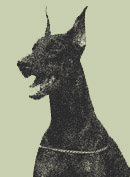If you happened to be on the market place in the village of Apolda, in the state of Thuringen,
in the southern part of Germany, you would see a very curious scene – a “dog market”.
Such “dog markets” had been held in Thuringen since 1863 every year. Its purpose was to improve the strains and to educate owners as to the advantages
of pure breed dogs. At that time the pure bred dogs were quite rare and very few people took upon themselves the task of breeding them.
The dogs were divided into various classes: ceremonial, hunting, house, butcher and Shepard dogs.
Fridrich Louis Dobermann was born January 2nd, 1834. There is little information about his life. There are some
facts that he was employed as a tax collector, a “dog catcher”, a night watchman, and as a supervisor for local slaughter houses. As a night watchman,
Herr Dobermann found his need for a suitable dog to accompany him on his rounds. It is also not beyond imagining a protection dog would be desirable
while working as a tax collector carrying large amounts of money.
Herr Dobermann also had a great interest in breeding dogs and was certainly exposed, through his various occupations and by attending
the “dog market,” to a variety of dogs. That enabled him, along with his two friends, Herr Rebel and Herr Stegmann, to produce within a few generations
dogs that quickly became renowned as a fearless protection dog. These dogs could also be used as a gun-dog, for eradicating vermin, and for herding sheep.
They were said to be very intelligent, to have great stamina, and were highly trainable.
The first official records of the Dobermann appear in the stud books of the Dobermann pinscher Verein stud book of 1890 in Germany.
The dog’s name is first recorded in England in 1917 in the Policeman’s Monthly.
The Dobermann is one of the few breeds that has been named after a person. There is also record of an heirloom photograph of Herr Dobermann,
given for a prize at one of the dog shows, which indicates that Herr Dobermann was acknowledged as a respected breeder and his dogs were held in high regard.
Otto Goeller, who became very interested in the breed and used the kennel name of Thuringen, is credited with further refining and stabilizing
the breed. In 1889, Herr Goeller established the first “Dobermann Pinscher Club.” .
Herr Goeller, along with a fellow townsman Herr Gorswin who bred Dobermanns bearing the kennel name of Groenland, produced several
of the most important Dobermanns in the breed’s history. These dogs can be found in the ancestry of the modern Dobermann.
Even though the Dobermann was originally bred as a guardian and personal protector, the Dobermann has an excellent nose for tracking
and has been used for capturing felons. For many years the Dobermann has been chosen to become an outstanding member of Search and Rescue Teams.
A few owners have been surprised by the pointing and retrieving instincts of the Dobe and have made excellent hunting companions out of their pets. Dobes
can also be found herding sheep (one such Dobe even has a Herding Dog Certificate) and bringing the cows in at milking time.
The Dobermanns loyalty, devotion, confidence and high degree of trainability (in the right hands) made the Dobermann the dog of choice by the
USMC during WWII; giving his life for his country. In contrast, this same breed has been and is still being used as a guide dog as well as an outstanding
therapy dog.
Modified from Doberman Review





